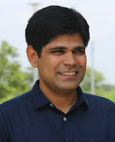Vineet Vashista
Assistant Professor, Mechanical Engineering
Indian Institute of Technology Gandhinagar (IITGN)
Palaj, Gandhinagar 382355, India
Research Interests
My research aims at the development of novel human-centered robotic technologies to improve the quality of human life. The focus is on the system design and control to apply desired interventions with minimum external constraints on human. I am interested in studying human adaptation to these haptic interventions to develop appropriate rehabilitation paradigms for people with neuro-musculoskeletal impairments.
Education
| Ph.D. 2015 | Mechanical Engineering, Columbia University, New York, USA |
| M.Tech. 2008 | Mechanical Engineering, Indian Institute of Technology Delhi, India |
| B.E. 2006 | Mechanical Engineering, Maharishi Dayanand University Rohtak, India |
Positions Held
| Nov’15 – present | Assistant Professor, Indian Institute of Technology Gandhinagar |
| June’08 – July’09 | Project Scientist, Indian Institute of Technology Delhi |
Awards/Distinctions
| 2016 – 2021 | INSPIRE Faculty Award, DST, India |
Publications
Journal Articles:
- Vashista, Moiz Khan, and S. K. Agrawal, “A Novel Intervention to Apply Gait Synchronized External Pelvic Forces to Reduce User’s Walking Effort,” IEEE Robotics and Automation Letters (in press).
- Martelli, V. Vashista, Silvesto Micera and S. K. Agrawal, “Direction-dependent adaptation of dynamical gait stability following waist-pull perturbations,” IEEE Transaction on Neural Systems and Rehabilitation Engineering (in press).
- Vashista, D. Martelli and S. K. Agrawal, “Locomotor Adaptation to an Asymmetric Force on the Human Pelvis directed along the Right Leg,” IEEE Transactions on Neural Systems and Rehabilitation Engineering 2015 (in press).
- J. Duan, V. Vashista and S. K. Agrawal, “Effect on Wrench Feasible Workspace of Cable-Driven Parallel Robots by Adding Springs”, Mechanism and Machine Theory, vol. 86, pp. 201-210, 2015.
- Vashista, N. Agrawal, S. Shaharudin, D. S. Reisman and S. K. Agrawal, “Force Adaptation in Human Walking with Symmetrically Applied Downward Forces on the Pelvis,” IEEE Transactions on Neural Systems and Rehabilitation Engineering, vol. 21(6), pp. 969-78, 2013.
Peer-Reviewed Conference Articles:
- Martelli, V. Vashsita, S. Micera and S. K. Agrawal, “Locomotor adaptations following repeated waist-pull perturbations,” In Rehabilitation Robotics (ICORR), 2015 IEEE International Conference on (pp. 636-641). IEEE.
- Kang, V. Vashista and S. K. Agrawal, “A novel assist-as-needed control method to guide pelvic trajectory for gait rehabilitation,” In Rehabilitation Robotics (ICORR), 2015 IEEE International Conference on (pp. 630-635). IEEE.
- Aggarwal, M. Behari, S. K. Agrawal, I. Pretzer-Aboff, K. N. Winfree, G. Dhankar, T. Shiva and V. Vashista, “Clinical outcomes of step synchronized vibration training in Parkinson’s disease patients,” In MOVEMENT DISORDERS (Vol. 30, pp. S424-S424), June 2015.
- H. Park, D. Zanotto, V. Vashista, X. Jin, P. Stegall and S. K. Agrawal, “Second Spine: A Device to relieve stresses on the upper body during loaded walking,” In Biomedical Robotics and Biomechatronics, 2014 IEEE RAS & EMBS International Conference on. (pp. 689-694).
- Vashista, X. Jin and S. K. Agrawal, “Active Tethered Pelvic Assist Device (A-TPAD) to Study Force Adaptation in Human Walking,” In Robotics and Automation (ICRA), 2014 IEEE International Conference on (pp. 718-723).
- Lenzo, D. Zanotto, V. Vashista, A. Frisoli and S. K. Agrawal, “A New Constant Pushing Force Device for Human Walking Analysis,” In Robotics and Automation (ICRA), 2014 IEEE International Conference on (pp. 6174-6179).
- Vashista, D. S. Reisman and S. K. Agrawal, “Asymmetric Adaptation in Human Walking using the Tethered Pelvic Assist Device (TPAD),” IEEE International Conference on Rehabilitation Robotics (ICORR), pp. 1-5, 2013.
- H. Park, P. Stegall, D. Zanotto, V. Vashista, X. Jin and S. K. Agrawal, “Design of the Second Spine: A Secondary Pathway to Transfer Loads from the Shoulders to the Pelvis,” In International Design Engineering Technical Conferences (IDETC) and Computers and Information in Engineering Conference, ASME 2013.
- Vashista, N. Agrawal, S. Shaharudin, D. S. Reisman and S. K. Agrawal, “Force Adaptation in Human Walking with Symmetrically Applied Downward Forces on the Pelvis,” IEEE EMBS, San Diego, California USA, Aug. 28 – Sep. 1, 2012.
- Vashista, S. K. Mustafa and S. K. Agrawal, “Experimental Studies On The Human Gait Using A Tethered Pelvic Assist Device (T-PAD),” IEEE International Conference on Rehabilitation Robotics (ICORR), ETH Zurich Science City, Switzerland, June 29 – July 1, 2011.
- Vashista, X. Chen and S. K. Agrawal, “Adult-Human Learning on a Robotic Wheelchair Using a Force Feedback Joystick,” Proc. of the Int. Nat. Conf. on Mach. And Mech. (iNaCoMM), IIT Roorkee, India, Dec 18-20, 2013.
- Vashista, A. Jere, S. Rane, V. Grover, and S. K. Saha,“Synthesis and analysis of a new mechanism for sheep shearing machine,” Proc. of the Nat. Conf. on Mach. And Mech., IISc Bangalore, India, Dec. 12-13, pp. 1-7, 2007.
- Rane, V. Grover, V. Vashista, A. Jere, and S. K. Saha, “Computer aided analysis of a sheep shearing machine,” CD-Proc. of the Nat. Conf. on Emerging Trends in Mechanical Engineering, SVNIT, Surat, June 4-5, pp. 1-10, 2007.
Symposium Presentations and Posters:
- Bishop, J. Stein, V. Vashista, M. Khan, S. Hinds, and S. K. Agrawal, “Stroke Survivor Gait Adaptations Using Asymmetric Forces with the Tethered Pelvic Assist Device,” American Congress of Rehabilitation Medicine Annual Conference 2015 (accepted).
- Vashista, S. K. Mustafa, and S. K. Agrawal, “Experimental studies on the human gait using a tethered pelvic assist device (TPAD),” Center for Biomedical Engineering Research Symposium, 2011.
- Vashista, X. Chen, S. Saharuddin, S. K. Mustafa, and S. K. Agrawal, “Adult-human learning on a robotic wheelchair using a force feedback joystick,” Center for Biomedical Engineering Research Symposium, 2011.
- N. Winfree, S. Saharuddin, V. Vashista, D. Hilgart, I. Pretzer-Aboff, and S. K. Agrawal, “An untethered shoe with vibratory feedback for improving gait of Parkinson’s patients: The PDShoe,” Center for Biomedical Engineering Research Symposium, 2011.

